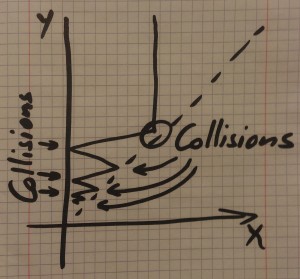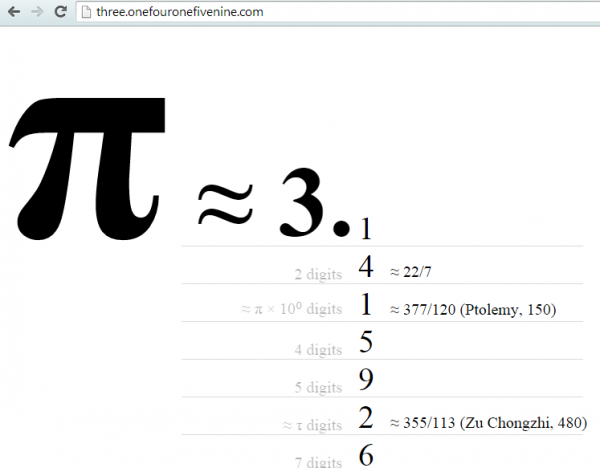We can’t hope to keep up with all the π action around the internet today, so here’s a live stream of #piday tweets.
You're reading: Posts Tagged: Pi Day
I bought three.onefouronefivenine.com
I’m a big fan of novelty domain names: I once bought hotmathematicians.com just so that christian@hotmathematicians.com could be my corresponding address when I submitted a paper. That domain has expired, but my love for one-shot novelty purchases has not!
To celebrate π day this year, I decided that it should be possible to type a little bit of π into the internet and be given the rest of it. You can have dots in domain names, so a domain like “three.something.com” is possible. I only know π to two decimal places off the top of my head, so I was dismayed to learn that onefour.com is being squatted.
After a bit of googling to find more digits of π (hey, this website will be really useful once I set it up!), I found the first decimal approximation which hasn’t already been registered:
three.onefouronefivenine.com
Try going there now. It really exists!
I’ve set it up so you get an endlessly scrolling list of decimal digits of π, generated using my favourite unbounded spigot algorithm. I suppose you can consider this my entry in our π approximation challenge.
A good π day’s work.
π approximation: Machin’s formula
In the excellent $\pi$ approximation video, Katie Steckles asked for $\pi$ approximations. I teach a first year techniques module (mostly calculus and a little complex numbers and linear algebra). This year I have changed a few bits in my module; in particular I gave some of my more numerical topics to the numerical methods module and took in return some of the more analytic bits from that module. This gives both modules greater coherence, but it means I have lost one of my favourite examples, from the Taylor series topic, which uses a Maclaurin series to approximate $\pi$.
π and the Mysterious Excel Function
Users of Microsoft’s flagship 2D-array-based data-organisation tool Excel will be aware of some if its more recondite functions. From the occasionally useful
RIGHT: returns the substring of a given length from the right-hand end of a cell’s contents
to the wilfully obscure
TBILLPRICE: gives “the price per $100 face value for a Treasury bill” when supplied with its settlement date, maturity date and discount rate
to the downright cryptic
N: obviously, converts its argument to a numeric format if it can
along with approximately 340 others, Excel’s abilities are near limitless.
But one function seems singular in the sheer decadence of its inclusion.
Matt Parker approximates π by weighing a circle
Stand-up mathematician Matt Parker has accepted our π approximation challenge. His method involves weighing a large cardboard circle.
So, how did that go? Fortunately, Matt got it all on video:
I think he deserves a round of applause for doing all that long division.
π, Phase Space, and Bouncing Billiard Balls

There are many ways to estimate or calculate π, that number that is irrational, but well-rounded. But perhaps none is as remarkable as that outlined in a 2013 paper by G. Galperin. In this brief article we’ll have a look at the problem, and see the setting, although we’ll leave the interested reader to hunt down the details.
π and The Simpsons

In “The Simpsons and Their Mathematical Secrets”, I documented all the mathematical references hidden in the world’s favourite TV show. Look carefully at various episodes, you will spot everything from Fermat’s last theorem to the Riemann hypothesis, from the P v NP conjecture to Zorn’s lemma.
All these references are embedded in the show, because many of the writers have mathematical backgrounds. To temper their nerdy enthusiasm, the general rule was that they could include as much mathematics as they fancied, as long as it was well hidden or only visible for a fraction of a second (a so-called freeze-frame gag).
However, if the mathematical reference is not particularly obscure, then it can be included at the heart of the action, and can even be included in the actual dialogue. π, of course, falls into this category, because everyone learns about it in school.
There are at least ten π references in “The Simpsons”, and here are my top three favourites, in reverse order:
